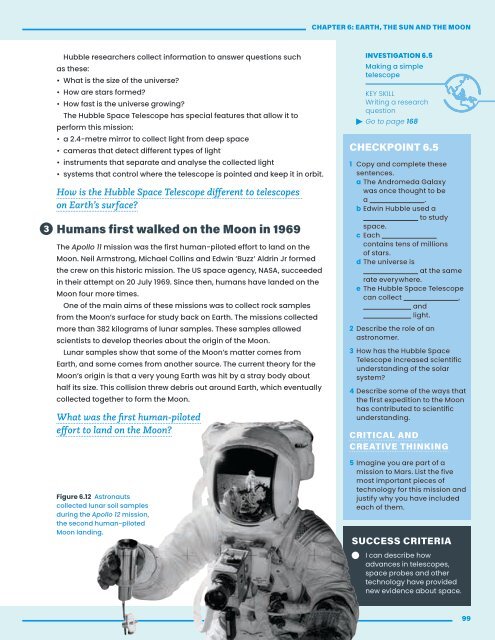Good Science Victorian Curriculum Year 7
Digital sample of Matilda's newest publication, Good Science Victorian Curriculum Year, authored by Emma Craven and Aaron Elias. For more information visit www.matildaeducation.com.au or email Katrina Tucker, katrinatucker@matildaed.com.au
Digital sample of Matilda's newest publication, Good Science Victorian Curriculum Year, authored by Emma Craven and Aaron Elias. For more information visit www.matildaeducation.com.au or email Katrina Tucker, katrinatucker@matildaed.com.au
Create successful ePaper yourself
Turn your PDF publications into a flip-book with our unique Google optimized e-Paper software.
CHAPTER 6: EARTH, THE SUN AND THE MOON<br />
3<br />
Hubble researchers collect information to answer questions such<br />
as these:<br />
• What is the size of the universe?<br />
• How are stars formed?<br />
• How fast is the universe growing?<br />
The Hubble Space Telescope has special features that allow it to<br />
perform this mission:<br />
• a 2.4-metre mirror to collect light from deep space<br />
• cameras that detect different types of light<br />
• instruments that separate and analyse the collected light<br />
• systems that control where the telescope is pointed and keep it in orbit.<br />
How is the Hubble Space Telescope different to telescopes<br />
on Earth’s surface?<br />
Humans first walked on the Moon in 1969<br />
The Apollo 11 mission was the first human-piloted effort to land on the<br />
Moon. Neil Armstrong, Michael Collins and Edwin ‘Buzz’ Aldrin Jr formed<br />
the crew on this historic mission. The US space agency, NASA, succeeded<br />
in their attempt on 20 July 1969. Since then, humans have landed on the<br />
Moon four more times.<br />
One of the main aims of these missions was to collect rock samples<br />
from the Moon’s surface for study back on Earth. The missions collected<br />
more than 382 kilograms of lunar samples. These samples allowed<br />
scientists to develop theories about the origin of the Moon.<br />
Lunar samples show that some of the Moon’s matter comes from<br />
Earth, and some comes from another source. The current theory for the<br />
Moon’s origin is that a very young Earth was hit by a stray body about<br />
half its size. This collision threw debris out around Earth, which eventually<br />
collected together to form the Moon.<br />
What was the first human-piloted<br />
effort to land on the Moon?<br />
Figure 6.12 Astronauts<br />
collected lunar soil samples<br />
during the Apollo 12 mission,<br />
the second human-piloted<br />
Moon landing.<br />
INVESTIGATION 6.5<br />
Making a simple<br />
telescope<br />
KEY SKILL<br />
Writing a research<br />
question<br />
Go to page 168<br />
CHECKPOINT 6.5<br />
1 Copy and complete these<br />
sentences.<br />
a The Andromeda Galaxy<br />
was once thought to be<br />
a .<br />
b Edwin Hubble used a<br />
to study<br />
space.<br />
c Each<br />
contains tens of millions<br />
of stars.<br />
d The universe is<br />
at the same<br />
rate everywhere.<br />
e The Hubble Space Telescope<br />
can collect ,<br />
and<br />
light.<br />
2 Describe the role of an<br />
astronomer.<br />
3 How has the Hubble Space<br />
Telescope increased scientific<br />
understanding of the solar<br />
system?<br />
4 Describe some of the ways that<br />
the first expedition to the Moon<br />
has contributed to scientific<br />
understanding.<br />
CRITICAL AND<br />
CREATIVE THINKING<br />
5 Imagine you are part of a<br />
mission to Mars. List the five<br />
most important pieces of<br />
technology for this mission and<br />
justify why you have included<br />
each of them.<br />
SUCCESS CRITERIA<br />
I can describe how<br />
advances in telescopes,<br />
space probes and other<br />
technology have provided<br />
new evidence about space.<br />
99


















